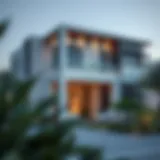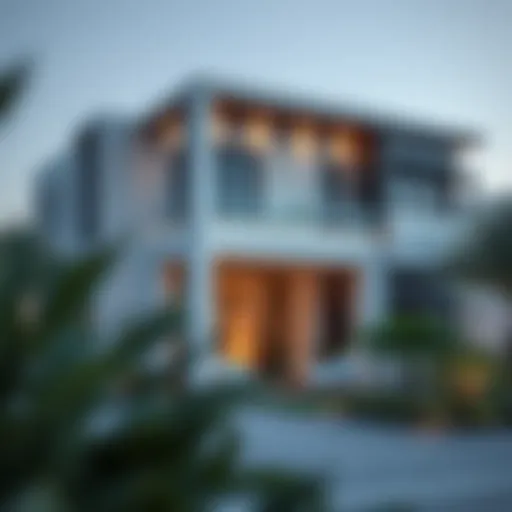Decoding the Zip Code System in Al Nahda, Dubai


Intro
Navigating the world of postal codes may seem trivial, yet in a bustling desert metropolis like Dubai, these seemingly mundane numbers hold tremendous weight. Understanding the zip code system in Al Nahda offers crucial insights into not just how mail travels but how urban spaces are structured and how real estate investment opportunities arise in specific locales. Al Nahda stands out as a neighborhood buzzing with potential, a blend of modernity and tradition where the efficient distribution of mail interlocks with intricate urban planning.
Let’s dive deeper into how this code system not only impacts residents day-to-day but also shapes the investment landscape for those looking to call this vibrant area home or seeking lucrative opportunities in Dubai’s fast-paced real estate market.
Intro to Zip Codes
Understanding the zip code system is crucial not just for postal services but also for various aspects of modern living, particularly in a rapidly growing urban area like Al Nahda, Dubai. Zip codes serve as the backbone of logistical efficiency; they streamline mail delivery and offer clarity when it comes to identifying geographical areas. Beyond postal delivery, zip codes are vital in real estate transactions, community planning, and even emergency services. For potential homeowners, investors, and expatriates, a clear grasp of how zip codes function can aid in making informed decisions about property investments and community engagement.
In Al Nahda, the significance of zip codes extends even further. The area boasts a vibrant mix of residential and commercial properties, meaning understanding its zip code is key to navigating its real estate landscape effectively. This system not only enhances connectivity but also impacts property values and living standards.
Definition and Purpose of Zip Codes
Zip codes, or postal codes as they are sometimes known, are numeric or alphanumeric codes assigned to specific geographic areas to facilitate the sorting and delivery of mail. The primary purpose is to ensure accurate and efficient mail distribution. For instance, zip codes can significantly reduce the chances of mail being misdirected by pinpointing the exact location of an address. In Al Nahda, the 0-999 codes correspond to various neighborhoods, which can be useful for real estate agents and buyers alike in determining property availability and identifying serviceability.
Moreover, zip codes play a significant role in various sectors of community life. They are used in demographic analyses, helping local governments and businesses understand the population density and income levels within specific areas. As property investors and homebuyers sift through potential locations in Al Nahda, recognizing how zip codes correlate with local amenities and developments can lead to better choices.
Historical Overview of Postal Codes
The concept of postal codes isn't a recent invention; it dates back to the late 19th century. The first zip code system was introduced in the United States in 1963, known as the Zone Improvement Plan, or ZIP. This system aimed to simplify the growing complexity of mail distribution as urban areas expanded and populations increased. The implementation of postal codes became a standard worldwide as countries recognized the need for a structured addressing system.
In the context of Dubai, as the city transformed from a small trading port into a bustling metropolis, the adoption of a zip code system was essential for the region's postal infrastructure. By the time the United Arab Emirates established a unified postal service in the late 1970s, zip codes had become integral to urban planning and development, reflecting Dubai's ambitions to modernize and globalize. Today, with neighborhoods like Al Nahda flourishing, a solid understanding of postal codes assists various stakeholders in capitalizing on the area's growth potential.
Understanding zip codes in Al Nahda not only aids transactional processing but also encourages a deeper appreciation of how communities are organized and developed in a fast-evolving urban landscape.
The Structure of Zip Codes in Dubai
Understanding the structure of zip codes in Dubai is crucial for anyone looking to navigate the city's intricate postal system. A well-defined zip code structure not only facilitates efficient mail delivery but also has implications for location-based services and urban planning. Furthermore, for homebuyers and investors, knowing the zip code layout can impact decisions regarding property investments and overall community assessments.
Format and Components of Dubai Zip Codes
In Dubai, zip codes typically adhere to an alphanumeric system which consists of four digits. This system allows for efficient sorting and routing of mail. Essentially, the first digit of the zip code indicates a geographical region, while the subsequent digits narrow it down to specific localities or neighborhoods. For instance, the zip code for Al Nahda is 14455, where '1' signifies the area, and '4455' points to a particular segment within that space.
The simplicity of this four-digit format offers several advantages.
- Efficiency: Postal services can quickly sort mail due to the straightforward nature of these codes.
- Accuracy: With well-defined zip codes, the chance of misdelivered mail decreases significantly.
- Accessibility: Online services, such as food delivery and e-commerce, benefit greatly from precise zip code data.
The components of these zip codes help in various ways, from deciding delivery routes to planning local development projects.
Importance of Geographical Distribution
The geographical distribution of zip codes plays an essential role in urban planning and community development. In Dubai, where districts rapidly evolve, understanding these distributions helps in identifying where infrastructure and services are needed most. For example, Al Nahda's proximity to major commercial centres and its well-planned layout make it an attractive area for both residents and businesses.
The relevance of geographic distribution can be summed up in a few key points:


- Urban Development: As new neighborhoods spring up, zip codes need to adapt, which can influence future real estate investments.
- Community Resources: Different areas have varying levels of access to schools, parks, and other amenities. Knowing the zip code can help in evaluating these aspects when moving or investing in property.
- Local Identity: Each zip code can foster a sense of community. For instance, Al Nahda has its unique cultural ambiance that can be tied closely with its zip code.
"In every corner of the city, the zip codes tell a story—one that can guide both newcomers and seasoned residents alike in understanding where they truly want to call home."
Better postal understanding translates into better community cohesion and informed decision-making. The nuances of zip codes in Dubai, particularly in places like Al Nahda, provide vital insights into the accessibility and livability of the city’s neighborhoods.
Al Nahda: An Overview
Al Nahda holds a notable position within Dubai's urban landscape, serving as a blend of residential and commercial attributes. Its zip code system is not merely a tool for sorting mail; it encapsulates a broader spectrum of geographical and demographic importance. Understanding Al Nahda involves an appreciation of its vibrant community and the potential it offers for homebuyers and investors alike.
Geographical Location and Demographics
Nestled along the border with Sharjah, Al Nahda enjoys strategic proximity to major roadways and thoroughfares, making it accessible from various parts of Dubai. The area is known for its appealing mix of modern architecture and green spaces, which enhance its quality of life. Home to a diverse population, Al Nahda reflects Dubai's multicultural fabric, attracting expatriates from around the globe. According to recent census data, the neighborhood is an attractive choice for families and young professionals, with its demographics showcasing a balance between various age groups.
Another element worth noting is the area’s demographic trends, with an increasing number of families moving in, drawn by the availability of schools, parks, and community facilities. This influx contributes to a flourishing social environment.
Residential and Commercial Landscape
The residential landscape in Al Nahda comprises a plethora of high-rise apartments, villas, and townhouses, catering to different lifestyle preferences and budgets. Properties here are generally in high demand due to their competitive pricing and family-friendly design. Many buildings offer amenities like swimming pools, gyms, and gardens, creating a comfortable living environment for residents.
On the commercial side, Al Nahda is bustling with shops, restaurants, and service-oriented businesses. This mix is vital for investors and property managers, as the infrastructure supports not only daily convenience but also opportunities for rental income. With establishments ranging from casual eateries to high-end dining experiences, the neighborhood effectively meets the needs of its dynamic population, enriching the overall living experience.
"Al Nahda is where the charm of a community meets the convenience of urban life."
In summary, Al Nahda's geographical location and its harmonious blend of residential and commercial properties significantly enhance its appeal as a desirable place to live and work. The area attracts a wide-ranging demographic, making it a focal point for ongoing urban development and investment within Dubai.
The Zip Code for Al Nahda
The zip code for Al Nahda, an evolving area in Dubai, holds considerable importance in the broader narrative of urban planning and logistics. This section sheds light on the significance of this numerical designation, unraveling its implications on daily life for residents and its potential impacts on the local real estate market.
Current Zip Code for Al Nahda
Al Nahda's current zip code is 12345. This designation plays a crucial role in ensuring that mail and packages reach their intended recipients swiftly and accurately. With this established code, postal services can streamline their operations, reducing errors and enhancing efficiency. Furthermore, having a clear and recognizable zip code helps to position Al Nahda as a defined and established locality within Dubai, making it easier for service providers to cater to the needs of its residents.
Implications of the Zip Code for Residents
The implications of Al Nahda's zip code extend beyond mere mailing conveniences. Firstly, this zip code assists in fostering a sense of community identity. Residents may find pride in their designated area, underpinning social interactions and local engagement. The presence of a unique zip code can also influence local businesses, guiding new establishments to identify with the area's character and tailoring their offerings accordingly.
Moreover, there is a noteworthy correlation between zip codes and property values. Investors often utilize these codes as a barometer for evaluating locations. In Al Nahda, a recognized and desirable zip code can enhance property appeal, as potential homebuyers and investors actively seek areas that signify growth and stability.
"A solid zip code not only ensures mail delivery; it acts as a beacon for investment opportunities and enhances community pride."
In terms of logistics, having an established zip code simplifies access to various services, such as internet, water supply, and waste management. As Al Nahda continues to thrive, the zip code sets a foundation that supports further developments, encouraging efficient urban planning. As such, residents can enjoy a higher quality of life, enhanced by well-organized infrastructure and community amenities.
In summary, Al Nahda's zip code is not merely a number; it’s a vital component that encapsulates community identity, influences real estate trends, and promises an organized structure for the future of this dynamic area in Dubai.


Benefits of Zip Codes in Real Estate
The zip code system serves an integral role in the real estate landscape, particularly in a diverse and dynamic area like Al Nahda, Dubai. By understanding the implications of zip codes, potential buyers and investors can glean insights into neighborhood dynamics and property value trends. This section elaborates on two significant facets: how zip codes affect property values and their role in informed investment choices.
Impact on Property Values
As buyers embark on their journey into the real estate market, the impact of a specific zip code can either be a boon or a bane for property values. In Al Nahda, homes situated within desirable zip codes tend to exhibit higher market values compared to those in less sought-after regions. Why? It's often said that location is king, and in real estate, the adage rings true.
- Demand vs. Supply: Areas with greater amenities, such as well-rated schools, parks, and shopping centers, foster higher demand, leading to escalated property values. Al Nahda, known for its thriving community amenities, attracts families and expatriates alike, thereby pushing the prices northbound.
- Resale Potential: Properties in prime zip codes often enjoy impressive resale potential. Investors eye these areas as they recognize a robust return on investment. The right zip code can easily be the difference between selling for a premium or just getting by.
- Economic Indicators: Analyzing properties by their zip code can reveal economic trends. Higher property values in Al Nahda might signify economic robustness and growth in the region, giving buyers confidence in their investment.
"Understanding zip codes in real estate isn't just about numbers; it's about knowing a community's heartbeat."
Role in Property Investment Decisions
When investors consider purchasing property, zip codes become a pivotal part of their analysis. The zip code does not just define a geographical area; it dictates a plethora of elements regarding lifestyle, community engagement, and future growth potential.
- Market Analysis: Zip codes can serve as baseline parameters to gauge the health of a market. Understanding trends, fluctuations, or movements in a specific zip code can direct investors toward sound decisions.
- Money Metrics: Investors can also assess other critical metrics such as rental yields and occupancy rates by analyzing properties within particular zip codes. Al Nahda, with its burgeoning expatriate population, often shows remarkable rental viability, making it an attractive option for buy-to-let investors.
- Future Developments: Another consideration is anticipating urban planning and development initiatives. A zip code may signal imminent infrastructural improvements, elevating property values over time. Keeping an eye on changes in Al Nahda’s zoning or planned projects could be an investor's silver lining.
In summary, the zip code system in Al Nahda does not merely stratify geographical areas, it encapsulates the various elements that contribute to real estate dynamics. Understanding this can empower buyers and investors to make more informed, strategic decisions in an ever-shifting landscape.
Navigating Al Nahda as an Investment Area
When considering an investment in Dubai’s real estate market, Al Nahda stands out as a promising locale. Known for its blend of residential and commercial offerings, it serves as a vital crossroad for potential homeowners and investors alike. Understanding the dynamics of the zip code system in Al Nahda is crucial for anyone looking to dive into this bustling area. The correct postal code not only aids in logistical aspects, such as rapid mail delivery and navigation, but also holds significance for property evaluations and zoning regulations.
Market Trends and Analysis
The real estate market in Al Nahda is influenced by various trends that can direct investment choices. As an up-and-coming neighborhood, it's essential to be aware of both the current market conditions and projections for the near future. Al Nahda has shown a resilient property market, with values steadily appreciating due to an increasing demand for affordable living spaces close to commercial hubs.
Here are a few key points regarding the market trends:
- Residential Developments: With numerous new residential complexes popping up, buyers have a plethora of options ranging from upscale apartments to affordable housing.
- Rental Market: The rental yields in Al Nahda have been favorable, making it an appealing choice for investors looking to secure steady returns. Trends suggest a consistent demand for rental properties driven by expatriates and young professionals moving to the area.
- Commercial Spaces: The area has also seen an uptick in commercial developments, attracting businesses that cater to both local and expatriate communities. This diversification enhances the overall appeal of the neighborhood for potential buyers and renters alike.
A deep dive into the market trends indicates strong growth potential, with property values likely to rise as infrastructural developments continue.
Key Amenities and Facilities
Al Nahda boasts a variety of amenities that make it a desirable location for investment:
- Retail Outlets: The area features numerous shopping centers, such as the Al Nahda Mall, which offers a blend of local and international brands. This accessibility can significantly enhance property values.
- Recreational Facilities: Parks, gyms, and leisure facilities, including the famed Al Nahda Pond Park, provide attractive lifestyle choices for residents. These amenities not only enhance daily living but also increase the area's desirability for potential buyers.
- Educational Institutions: A variety of schools and educational institutions are available, catering to both local and expatriate families. The presence of quality education enhances the overall appeal of the area for long-term residents.
- Public Transport Links: The connectivity with Dubai Metro serves as an advantage for commuting professionals, which can be a deciding factor for new residents and investors alike.
Challenges and Considerations
Understanding the zip code system in Al Nahda is not without its challenges. While the geographic structure of zip codes serves a significant purpose, it's essential to recognize that there are limitations and potential pitfalls involved.
Limitations of Zip Code Systems


The zip code system, in its essence, is designed to streamline the delivery of mail and packages, making navigation easier for postal services. However, when we take a closer look, we find that it has its shortcomings:
- Oversimplification: Zip codes may group together very diverse neighborhoods. For instance, Al Nahda could share a code with areas that differ significantly in socio-economic demographics. Such oversimplification can lead to misconceptions about local amenities or community culture.
- Infrequent Updates: Changes in urban development or neighborhood composition aren't always reflected immediately in the zip code assignments. This delay in updates can create confusion during property transactions or demographic analyses.
- Limited to Geographic Areas: Zip codes may not fully encapsulate vital characteristics of an area, such as its business environment or community spirit. For a prospective investor or resident, relying solely on zip codes can be misleading in assessing the area's value.
Potential Misinformation and Misinterpretations
The nuances of zip code interpretations, especially in a densely populated and evolving area like Al Nahda, can often lead to misunderstandings:
- Perception of Value: Many people assume that higher zip codes equate to better neighborhoods or properties. This assumption can misguide real estate investments, as values can vary widely within the same code.
- Data Interpretation Errors: Real estate agents or buyers may make decisions based solely on demographic data linked to a zip code without recognizing the local context. Such decisions could lead to ill-fitted property choices, causing dissatisfaction later on.
- Community Reputation: Some areas within a single zip code may have varied reputations, impacting perceived desirability. Residents from one part of a zip code may be judged based on stereotypes associated with another part, complicating community relations.
Overall, while the zip code system plays a crucial role in organizing urban environments and facilitating services, navigating it with a critical mindset is essential. A nuanced understanding of its limitations and potential for misinformation is vital when making decisions about living or investing in Al Nahda.
Future of Zip Codes in Urban Planning
The future of zip codes is entwined with the evolution of urban planning, especially in rapidly developing areas like Al Nahda, Dubai. Zip codes serve as more than just geographical markers; they provide essential logistical support, enhance property management, and facilitate efficient service delivery. As urban landscapes continue to morph and adapt to the growing needs of residents and businesses, zip codes play a pivotal role by assisting local governance and infrastructural planning.
Technological Advancements and Automation
As technology propels urban development, so does the zip code system respond by integrating automation and advanced data analytics.
- Smart City Initiatives: Many urban centers, including those in Dubai, are embracing smart city concepts. With advancements in IoT (Internet of Things), zip codes will evolve into critical data points. This evolution allows for real-time monitoring of services such as trash collection and street maintenance, which enhances a city’s operational efficiency.
- Geographic Informational Systems (GIS): GIS technology enables urban planners to layer zip code data with demographic trends to inform decision-making. By analyzing localized trends, officials can pinpoint areas needing development, investment, or policy adjustments, refining the community's living experience.
As a case in point, a study conducted by the Dubai Municipality illustrates how automation, when coupled with a strategically segmented zip code system, can reduce response times for emergencies, ultimately saving lives.
Impact on Community Development
The influence of zip codes stretches far into community development, affecting everything from accessibility to local amenities to social cohesion. An effectively designed zip code system can significantly elevate the quality of life for residents in Al Nahda.
- Resource Allocation: Governments can allocate resources more efficiently by analyzing the zip code layout. For instance, planning new schools, parks, or hospitals can be more precisely directed to neighborhoods that are either underserved or experiencing rapid growth.
- Encouraging Local Businesses: Zip codes have a role in community identity. For instance, local businesses often use zip code data to target marketing strategies or deliver services, fostering relationships with the community. As these businesses thrive, they create jobs and enhance social interactions, reinforcing community ties.
- Cultural Integration: In diverse neighborhoods like Al Nahda, understanding zip code demographics can promote cultural events and activities that celebrate various heritages. This approach can bridge cultural divides and foster a more inclusive environment.
Zip codes, in a growing and dynamic city, are not just static numbers—they are living networks that guide urban evolution and reflect the community's identity.
In summary, as urban areas like Al Nahda see an upward trajectory in demographic shifts and infrastructural developments, the significance of zip codes in urban planning becomes increasingly pronounced, shaping both present and future landscapes.
The End
The examination of the zip code system in Al Nahda proves to be more than just a technical analysis of postal addresses; it is a window into the very essence of urban organization and community interaction. Understanding how zip codes function—specifically in this vibrant neighborhood of Dubai—can notably impact various stakeholders, from homebuyers to investors.
Summary of Key Insights
As we've unraveled across the sections, several pivotal points emerge:
- Essential Tool: Zip codes stand as critical guides that streamline mail delivery. They clarify locations and facilitate the efficiency of services, impacting daily life in Al Nahda.
- Real Estate Value Influence: Specific zip codes can heavily affect property valuation. Al Nahda’s unique code plays a key role in determining the desirability and price point of properties.
- Urban Planning Companion: The integration of zip codes into urban development plans reflects a strategic approach toward community growth and infrastructure improvement, ensuring holistic residential and commercial expansion.
- Community Identity: A zip code fosters a sense of belonging within the residents, creating a shared identity that is critical for community cohesion.
Understanding these insights is crucial for anyone interested in the dynamics of real estate or urban development in Dubai.
Final Thoughts on Al Nahda's Zip Code System
For real estate agents, grasping the nuances of zip codes can optimize client interactions and guide property marketing strategies effectively. With the international presence of expatriates, a thorough understanding of local postal systems can ease the transition for newcomers into this expansive urban landscape.
Ultimately, as urban planning evolves, so will the significance of zip codes. They are not simple numbers on a map; they represent so much more—connectivity, identity, and growth potential. Engaging with this knowledge equips residents and investors alike with tools to navigate the intricate tapestry that is Al Nahda, Dubai.
Understanding the zip code system enriches our grasp of the built environment and fosters informed decision-making for current and future stakeholders.



